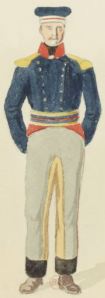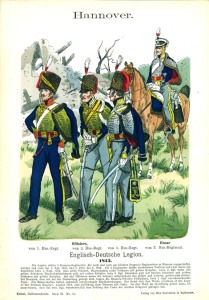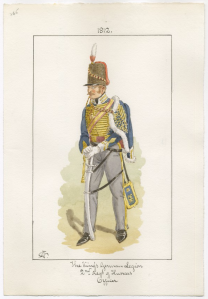My overwhelming interest, as posts here show, is in the auxiliary forces of the Georgian period, but recent discoveries have sparked a new interest in the dress of the King’s German Legion. I’ll be laying out some aspects of this in a set of pages here, beginning with some thoughts on sources, then moving on to look at elements of the dress of the Legion in the light of those sources. If and when new information comes along, these pages will be amended.
page 9: ‘Heavy’ Dragoons 1803-13
page 10: Light Dragoons 1813-16
page 15: Depot Company, Independent Garrison Company, Veteran Battalion
Not surprisingly, readily available primary evidence for the appearance of the KGL is thin and patchy, but over the years a ballooning mass of secondary material has been piled up on these skinny foundations, some of which needs to be questioned. As so often with uniformological matters, sheer repetition by later writers and illustrators has had the effect of fixing in cement features of dress that may or may not be speculative in origin. For example, many details of modern standardised images of the KGL have been derived uncritically from the work of Knötel, which should be used with care.
Primary sources
First then, a quick survey of some primary sources – skipping various isolated bits and bobs, and with no pretence at completion, but just as a pointer to some useful references.
Preserved items
The Bomann Museum at Celle holds these KGL items:
· Wooden Canteen, possibly from one of the two light Battalions
· Baker Rifle, of one of the light infantry detachments of the 4th Line Battalion
· Pistol, of the 1st Light Dragoons
· Coat, of General Carl von Alten
· Coat, Sergeant, Grenadier Company, 4th Line Battalion
· Coat, Sergeant, Center Company, 4th Line Battalion
· Coat and Cab, Color-Sergeant, 7th Line Battalion
· Coat, Officer 1st Line Battalion
· Coat, Sergeant-Major, 3rd Hussars Regiment
· Coat, Cross-Belt and Pouch, Officer, Horse Artillery
· Cap, 3rd Line Battalion
· Gorget, Officer
· Sash, Officer, of a Hussars Regiment
· Sword Belt with Cross Belt Plate (Officer’s style), of a Line Infantry Battalion
· Sash, Officer, of a Line Infantry Battalion
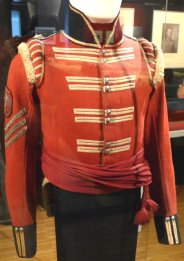 I’ve not seen these in the flesh, but online searches throw up plenty of images. Among recent secondary sources (see below for a survey of these), Von Pivka’s 1974 Osprey has b & w photos of variable quality of some of these, while the Partizan Press compilation by John Grehan includes colour photos of three jackets, including useful rear views, though those of the battalion company sergeant are wrongly captioned.
I’ve not seen these in the flesh, but online searches throw up plenty of images. Among recent secondary sources (see below for a survey of these), Von Pivka’s 1974 Osprey has b & w photos of variable quality of some of these, while the Partizan Press compilation by John Grehan includes colour photos of three jackets, including useful rear views, though those of the battalion company sergeant are wrongly captioned.
The Hamburg Museum holds the jacket of Surgeon Georg Gerson of the 5th Line Battalion. Images can be tracked down online.
The Stadtmuseum at Hanover has jackets of an officer of the 5th Line Battalion and of a corporal of the Heavy Dragoons. There is one image of each in Hofschröer’s Osprey (see below).
A fine officer’s jacket of the 3rd Hussars is held by the Museum für Hamburgische Geschichte, Hamburg; a black and white photo of this is included in Mollo’s Waterloo Uniforms (see below).
A greatcoat attributed to the KGL and said to have been worn by Wellington, now in the Guards Museum, is shown online here, but is authoritatively stated to be of a much later date. I suspect that this coat may be the basis of the belief that KGL greatcoats were single breasted and capeless, though I am not certain of that.
Period images
- von Röder
- Klein
- Hamilton Smith
- Langendijk
- Beamish
- von Hugo
- Rubens
von Röder
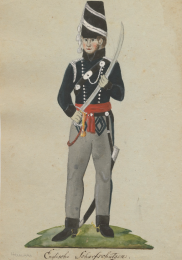 In the Anne S K Brown Military Collection at Brown University, and available in high resolution online, is a set of more than two dozen naïve eyewitness watercolours of uniforms of Wallmoden’s army of 1813 by a von Röder (first name not given). Five of these, though titled “Englische”, appear to be of elements of the KGL, and three have been annotated thus in pencil. The five apparently show officers of a line and a light battalion, of foot and horse artillery and of the 3rd Hussars. No KGL study seems to have taken any account of these, but they are contemporary and of real value, even if they appear to include some inaccuracies. To give an example of their interest, the light battalion officer is shown wearing the jacket and pantaloons of the 1st Battalion with the “mirliton” cap associated with the 2nd. The von Röder images are discussed in Thomas Hemmann’s Die Dömitzer Bilderhandschrift aus dem Jahr 1813, available as an e-book and in Google Books preview. As I’m not a German reader, I can’t comment on it.
In the Anne S K Brown Military Collection at Brown University, and available in high resolution online, is a set of more than two dozen naïve eyewitness watercolours of uniforms of Wallmoden’s army of 1813 by a von Röder (first name not given). Five of these, though titled “Englische”, appear to be of elements of the KGL, and three have been annotated thus in pencil. The five apparently show officers of a line and a light battalion, of foot and horse artillery and of the 3rd Hussars. No KGL study seems to have taken any account of these, but they are contemporary and of real value, even if they appear to include some inaccuracies. To give an example of their interest, the light battalion officer is shown wearing the jacket and pantaloons of the 1st Battalion with the “mirliton” cap associated with the 2nd. The von Röder images are discussed in Thomas Hemmann’s Die Dömitzer Bilderhandschrift aus dem Jahr 1813, available as an e-book and in Google Books preview. As I’m not a German reader, I can’t comment on it.
Johann Adam Klein
Among the 72 coloured uniform drawings by Klein in the Hamburg Art Museum is one of a group of KGL infantry drawn from life in March 1815. Several details are of interest. The original can be found online as an alamy stock image, while a copy by Georg Schäfer is among his versions of Klein’s images in the Anne S K Brown collection.
Charles Hamilton Smith

Hamilton Smith’s well known plate series, Costume of the Army of the British Empire, contains a single plate of three figures representing the KGL. It is excellently reproduced in Philip J Haythornthwaite’s 2002 version under the title Wellington’s Army, while the original pencil drawing for the plate is online at the Anne S K Brown collection. In addition, the charts to Hamilton Smith’s plates include nine schematic entries for the KGL, which are useful and not without interest; they show, for example, both light battalions identically dressed by 1815, at variance with the usual sources.
Jan Anthonie Langendijk
Of the many images by this prolific artist in albums titled “Uniforms of the Armies of Europe Drawn by Langendyk” in the Royal Collection, seven are of cavalry of the KGL, of which four are available as online images. These comprise an officer and private of each regiment of 1813 Light Dragoons, a trumpeter of the 1st Light Dragoons (wrongly attributed to the 2nd Hussars), and privates of the 1st and 2nd Hussars. An eighth image, supposed to be an officer of the 1st Hussars, seems actually to be of the 10th Hussars of the British service, so is not included in the discussion here.
None of the seven are included in the plates to Miller and Dawnay’s 1966-70 catalogue, but they are briefly described there, and I have been able to study colour photos of them all, thanks to the kindness of Ben Townsend. Miller and Dawnay cast doubt on the originality of Langendijk’s images and on the “sensitivity” of his detail, but as contemporary depictions these images must deserve attention, and they do seem to include elements that must have originated in direct observation.
North Ludlow Beamish; the Beamish Centrepiece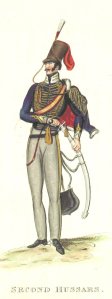
Beamish’s celebrated 1832 History of the King’s German Legion contains a well known and comprehensive series of uniform plates drawn by Count Castell of the 3rd Hussars, which have been influential. Though close to period and directly informed, they are retrospective and not entirely reliable in their detail. Even so, they are an essential reference. These were reproduced in Schwertfeger’s Geschichte der Koeniglich Deutschen Legion of 1907.
At the National Army Museum is an impressive piece of silver tableware presented to Beamish in 1839 by ex-officers of the Legion. The Centrepiece includes ten carefully modelled figures of men of the Legion, close in detail to the plates in Beamish’s history.
Ludolph von Hugo
John Mollo’s excellent Waterloo Uniforms 1: British Cavalry (see below) contains photos of two watercolours, and four drawings after other watercolours, of officers of the 2nd Light Dragoons, ex “Heavy” Dragoons, in various orders of dress. These invaluable images are referenced to “the Hugo Collection” at the Historisches Museum am Hohen Ufer, Hannover. I assume (but am happy to be corrected) that these are by Lieutenant Ludolph von Hugo of that regiment, and that at least one more painting in the series informs the plates by Bryan Fosten in his Wellington’s Heavy Cavalry (see below), though not specifically referenced by Fosten.
The Bibliothèque Royale in Brussels contains a folder of fluent watercolour uniform sketches by the Belgian artist J-B Rubens. Though the folder is dated to 1822, the sketches are dated to 1815, and appear to be taken from life; they may be studies for an intended painting of Waterloo. They are not available online, though a number were included by John Mollo in his Waterloo Uniforms (see below). Usefully, fifteen were copied in 1925 by Winand Aerts (see below) and are housed in an album titled “Croquis d’uniformes des armées anglaise et hanovrienne” in the Bibliothèque Nationale in Paris, available online. Among those not used by Mollo are four of KGL Light Dragoons, captioned by Rubens as artillery, but correctly re-identified by Aerts. These include some useful details.
Tailors’ books
- Stothard’s “Rigementals”
- The Meyer ledger
- The Pearse notebook
Stothard’s “Rigementals”
The Anne S K Brown Military Collection at Brown University contains a tailor’s notebook titled “Rigementals”; this is a collection of “Memorandoms” compiled around 1813 by the tailor William Stothard, with some fascinating drawings and notes. Images of the pages are not available online, though a drawing for the KGL is shown in Bryan Fosten’s 1981 Osprey, Wellington’s Infantry 1. “Rigementals” includes 12 entries for officers of the KGL: drawings of line and light battalion jackets, with the remaining items related to the Legion’s hussars, including detailed drawings of jackets, pelisses and pantaloons.
Stothard’s background is not known, but he was certainly familiar with officers’ clothing produced by London tailors from 1811. A number of items in the book can be tied to entries in the ledger of Jonathan Meyer (see the following item), and it’s possible that Stothard was at some point employed by Meyer.
The Meyer ledger
A ledger used by the London tailor Jonathan Meyer from 1809 survives at the successor firm of Meyer & Mortimer of Savile Row. As an accounts ledger, it contains no drawings, but entries do include brief descriptions of items made. Meyer seems to have had a particular reputation for pelisses, greatcoats, pantaloons and overalls. The contents are strong for cavalry, especially hussars, and for the KGL in general, well over 100 KGL officers being among the customers. Details can be gleaned from these entries that help to round out our knowledge of their appearance.
The Pearse notebook
One of the notebooks of the major clothiers J N & B Pearse, in the keeping of the Canadian War Museum, has a brief entry for the other ranks of the Line Battalions of the Legion, with two lace samples. This dates from 1803 or later, but it is impossible to be more precise.
Secondary sources
Next, a look at a few secondary sources, chosen either because they’re influential or because they’re readily available online. Modern images of the KGL exist in abundance, but tend to feed off each other; what follows may help to demonstrate the strengths and weaknesses of the whole.
Images
Richard Knötel
Knötel’s (1857-1914) monumental Uniformenkunde series contains (to the best of my knowledge) eleven plates devoted to the Legion, with a degree of duplication over the years. The later plates in particular are admirably drawn, and, given Knötel’s status, his work on the KGL has become a standard reference and the default inspiration for many subsequent illustrators. His debt to Castell’s images in Beamish and to Hamilton Smith (see above) is evident, but some figures include details whose origins are unclear, and it’s hard to know how sound these may be. Though splendid, his reconstructions should be viewed with a careful eye. Why, for instance, do his Light Battalion officers wear double silver trouser stripes? (See also comments on related images in Schäfer and von Pivka, below.)
In the Anne S K Brown Collection is a collection of 146 uniform watercolours by Charles Lyall, of which 22 are of of the KGL. Judging by the style of the monogram signature, these are probably by the opera singer, caricaturist and watercolourist Charles Lyall, c 1833-1911. They are pleasantly decorative, but derive directly from Knötel, with a few original errors of detail thrown in; they do not contribute anything to our knowledge of the KGL.
Winand Aerts (Aertz)
The Bomann Museum, Celle, holds a number of uniform watercolours by historian and illustrator Winand Aerts (1879- ?), dated to 1912-13. These are nicely done, but to be honest, it’s hard to spot anything in them not taken directly from Knötel. A further three are reproduced in Peter Hofschröer’s Osprey (see below) attributed to an “unknown artist”, though one is clearly signed by Aerts and dated 1913. A small number of other figures are included in Aerts’s undated album of handsome watercolours, “Göhrde, Quatre-bras, Waterloo, Troupes Hanovriennes. 1813-1815” in the Bibliothèque Nationale de France, and available online here. Some of these are not derived from Beamish or Knötel, and are discussed on page 2 and on page 4. They appear to offer new information, but as Aerts rarely identifies any sources it is hard to know how reliable they may be. Rather more valuable are the copies later made by Aerts of sketches by J B Rubens (see above).
Also in the Anne S K Brown Collection is a set of eight watercolours by Schäfer (1896-1975), dated to 1954, of uniforms of the 1st Light Dragoons / Hussars. Confidently executed, they include a number of convincing details extra to the primary evidence that I know of. Without knowledge of Schäfer‘s sources it’s difficult to make any judgement about this. To pick on just one doubtful point, an image of a trooper dated to 1803-5 [left] shows the Tarleton worn with what appears to be the light dragoon jacket of 1812. A similar figure for the 3rd Light Dragoons of 1809 in von Pivka (see below) is referenced to “a sketch by Knötel” that I’ve not been able to track down, but which surely has to be in error. (See discussion of this on page 5.)
I have no idea whether Schäfer created similar suites for other units of the KGL.
Books
- John Mollo
- Otto von Pivka
- Mike Chappell
- Other Osprey titles
- John Grehan
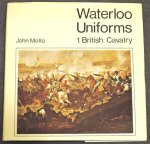 John Mollo, Waterloo Uniforms 1: British Cavalry, 1973
John Mollo, Waterloo Uniforms 1: British Cavalry, 1973
This impressively researched and illustrated study is narrow for our purposes, in that it is focused on the later period, and broad in that it covers all cavalry elements present at the battle of the title. Having said that, it contains a good deal of invaluable material, derived from primary sources, on the Light Dragoons and Hussars of the Legion. Some of this is used by later authors without attribution, and some has never been revisited to my knowledge, except on these pages. If only all modern sources were as careful and authoritative as Mollo!
Otto von Pivka, The King’s German Legion, Osprey Men-at-Arms series, 1974
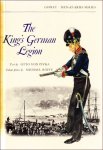 The plates in this early Osprey include a number of questionable or plainly incorrect features. As the compact format of the series leaves little or no space to reference details, the reader is obliged to think the worst. Use made of the Beamish images and of Knötel plates seems to have been uncritical. For one problematic example see my comment under Schäfer, above. Outside of the plates, the text is sparsely illustrated, mainly with useful photos of preserved items at Celle, though the quality of these is not always the best.
The plates in this early Osprey include a number of questionable or plainly incorrect features. As the compact format of the series leaves little or no space to reference details, the reader is obliged to think the worst. Use made of the Beamish images and of Knötel plates seems to have been uncritical. For one problematic example see my comment under Schäfer, above. Outside of the plates, the text is sparsely illustrated, mainly with useful photos of preserved items at Celle, though the quality of these is not always the best.
Mike Chappell, The King’s German Legion (1) 1803-1812; (2) 1812-1816, Osprey Men-at-Arms series 338 & 339, 2000
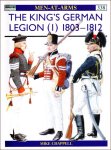 Osprey’s catch-up on the problematic von Pivka. There is evidence here of recourse to a wider range of good sources, such as the Wheatley diary. But given the limited space of an Osprey, even in a two part study, it’s hard to know which of the many new features are rooted in actual evidence and which are the products of reasonable speculation; Mike Chappell is such a superlative illustrator technically that he makes everything look entirely believable! But where did that Light Battalion knapsack design come from? Were Light Battalion caps really reinforced with leather on the crown and band, or is that just the impression given by Beamish? Is the design on the bass drum based on anything more than the side drum at Celle? And so on … There are a few elements here about which I feel bound to remain agnostic until evidence for or against comes my way.
Osprey’s catch-up on the problematic von Pivka. There is evidence here of recourse to a wider range of good sources, such as the Wheatley diary. But given the limited space of an Osprey, even in a two part study, it’s hard to know which of the many new features are rooted in actual evidence and which are the products of reasonable speculation; Mike Chappell is such a superlative illustrator technically that he makes everything look entirely believable! But where did that Light Battalion knapsack design come from? Were Light Battalion caps really reinforced with leather on the crown and band, or is that just the impression given by Beamish? Is the design on the bass drum based on anything more than the side drum at Celle? And so on … There are a few elements here about which I feel bound to remain agnostic until evidence for or against comes my way.
Other Osprey titles
 Bryan Fosten’s Wellington’s Infantry 2 (119, 1982), Wellington’s Light Cavalry (126, 1982) and Wellington’s Heavy Cavalry (130, 1982) all contain text and plates on elements of the Legion. I have enormous respect for Fosten’s work, but this doesn’t mean that there aren’t occasional issues created by over-reliance on Knötel. Peter Hofschröer’s The Hanoverian Army of the Napoleonic Wars (206, 1989), illustrated by Fosten, has its problems: Hofschröer’s text on uniforms is unsatisfactory and he seems to have relied, wisely, on the Fosten brothers for input to the plates. Even so, its coverage of the Legion includes a few useful images not shown elsewhere.
Bryan Fosten’s Wellington’s Infantry 2 (119, 1982), Wellington’s Light Cavalry (126, 1982) and Wellington’s Heavy Cavalry (130, 1982) all contain text and plates on elements of the Legion. I have enormous respect for Fosten’s work, but this doesn’t mean that there aren’t occasional issues created by over-reliance on Knötel. Peter Hofschröer’s The Hanoverian Army of the Napoleonic Wars (206, 1989), illustrated by Fosten, has its problems: Hofschröer’s text on uniforms is unsatisfactory and he seems to have relied, wisely, on the Fosten brothers for input to the plates. Even so, its coverage of the Legion includes a few useful images not shown elsewhere.
John Grehan, Britain’s German Allies of the Napoleonic Wars, Partizan Press, 2013.
 John Grehan is a prolific writer on things Napoleonic, but was he the man for the job here, even with the additional input of Bob Marrion? This compilation, well enough received in some quarters, also covers the armies of Hanover and Brunswick-Oels but still finds room for 50 odd pages on the Legion. Quite apart from anxieties about the cost and repro quality of my print-to-order copy, I can’t honestly recommend this book. Everything is thrown in, nothing is referenced or footnoted, illustrations are not tied to text, and images of the Legion are limited to Knötel prints, a couple of Marrion paintings, some amateurish line drawings done by someone else, and (heaven help us) a bunch of derivative cigarette cards. There are useful colour photos, side and back included, of three of the Celle jackets, but only three, and one of those is wrongly captioned. But I won’t go on.
John Grehan is a prolific writer on things Napoleonic, but was he the man for the job here, even with the additional input of Bob Marrion? This compilation, well enough received in some quarters, also covers the armies of Hanover and Brunswick-Oels but still finds room for 50 odd pages on the Legion. Quite apart from anxieties about the cost and repro quality of my print-to-order copy, I can’t honestly recommend this book. Everything is thrown in, nothing is referenced or footnoted, illustrations are not tied to text, and images of the Legion are limited to Knötel prints, a couple of Marrion paintings, some amateurish line drawings done by someone else, and (heaven help us) a bunch of derivative cigarette cards. There are useful colour photos, side and back included, of three of the Celle jackets, but only three, and one of those is wrongly captioned. But I won’t go on.

